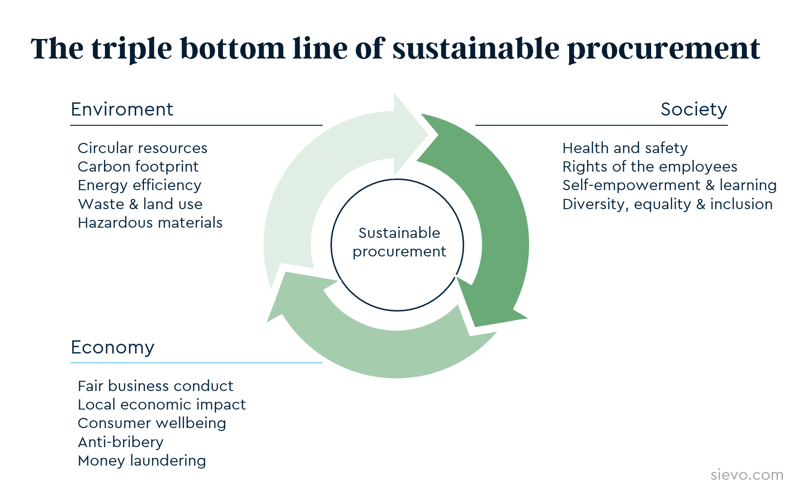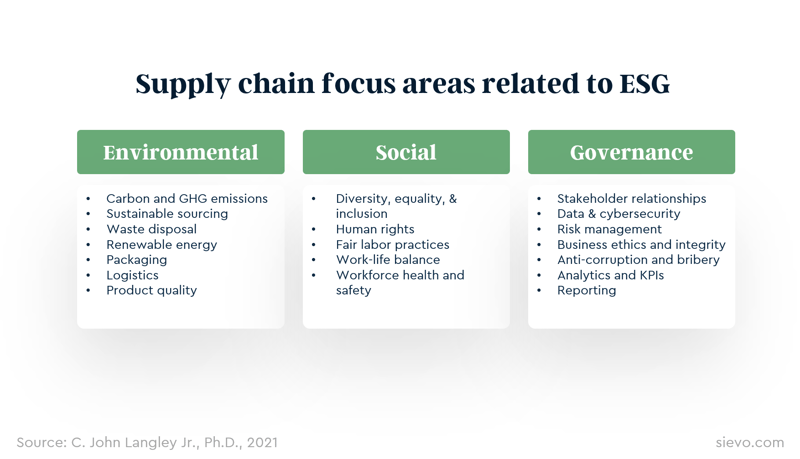Sustainable procurement is a process that integrates environmental, governance, and social factors of corporate responsibility into procurement processes and decision-making, while ensuring they still meet the stakeholder requirements. It aims for the lowest environmental impact possible and the most positive social results.
Learn how to get started with sustainable procurement in our ultimate guide, Sustainable Procurement 101
Within procurement and supply chain, sustainability can be defined as the process of making decisions that benefit not only the organization but society as a whole, while minimizing its impact on the environment. This means considering social and environmental factors alongside purely financial and economic ones.
This article will cover some of the common frameworks of sustainable procurement and gives a few category examples.

People, planet, and profit
Until recently, the focus of eco-friendly procurement has mainly been focused on environmental aspects. Also known as "green sourcing" and green procurement, this movement seeks to substitute one material for a more ecologically friendly alternative. Think of paper straws instead of plastic. But sustainable procurement has more to it than that.
Organizations are beginning to take a more holistic approach to sustainability. They consider environmental, social, and economic factors together.
These considerations start before entering a business relationship and continue throughout supply chain management.
Many procurement leaders are now recognizing their responsibility to drive positive change. Actions such as reducing their carbon footprint, using ethically sourced materials, cutting down on energy consumption, and streamlining shipping practices are practical steps to take.
Legislation is developing all the time and procurement needs to keep up to date on stakeholder requirements and demand for more sustainable products and processes.
The triple bottom line
The triple bottom line (TBL) is a business concept that suggests that companies go further than reporting on only their economic bottom line of financial performance. In addition, the social and environmental impact should be part of their reporting to shareholders. It is often expressed in the 3Ps, People, Profit, and Planet.
As organizations embrace sustainability, the shift is towards creating value for all stakeholders: these include customers, suppliers, employees, and members of their wider community.

The triple bottom line in procurement covers a number of themes, including environmental protection, waste, and hazardous materials, human rights, compliance, anti-bribery, fair labor, equality, diversity, employee well-being, education and development, and freedom of association.
Thinking about future generations
Sustainability means meeting our current needs without compromising the ability of future generations and societies to meet their own across time and geographies. This is the broad definition that has been globally accepted, coined in the 1990s by the Brundtland Commission in Norway, and endorsed by the UN.
Assessment of the footprint left in the society where a company operates is no longer a nice to have, but a mandatory requirement. Requirements for holistic sustainability are increasing for leading global companies, governments, and not-for-profit organizations.
Sustainable procurement is becoming embedded in day-to-day business operations and behaviors. The challenge for procurement is to integrate environmental and social considerations and decision points into the procurement process.
Meeting business needs
Companies need to fulfill changing customer preferences, comply with tightening regulations, and satisfy stakeholders. Leading global organizations recognize that sustainable supply chains can offer competitive advantages like improved efficiency, innovation, and market differentiation.
McKinsey's research shows that “Strong ESG credentials drive down costs by 5 to 10 percent, as these companies focus on operational efficiency and waste reduction.
Many companies are already running highly successful initiatives to optimize resource consumption within their operations or engage with their local communities. But the environmental and social footprint of a business extends far beyond its own walls (to get a deeper view into this, check out our article on Scope 3 emissions and what procurement can do).

Category examples of sustainable procurement
Single Use Plastics (SUP)
One new legislation impacting sustainable procurement is the Single-Use Plastics (SUP) Directive. Its goal is to prevent and reduce the impact of plastic products and to promote a transition to a circular economy.
Specifically, the directive targets these products:
- Cotton bud sticks
- Cutlery, plates, straws, and stirrers
- Balloons and sticks for balloons
- Food containers
- Cups for beverages
- Beverage containers
- Cigarette butts
- Plastic bags
- Packets and wrappers
- Wet wipes and sanitary items
Plastic straws could be replaced by metal ones. While the unit cost of a metallic straw may be higher compared to a plastic disposable one, it will last longer and produce less waste. Despite the low cost of plastic, eventually, metallic straws could be more economical because they are bought less frequently and disposed of less often.
Many airlines and restaurants prefer using rotable (re-usable) tableware instead of disposable ones. Rotable tableware includes the cost of dishwashing, but disposable items result in waste disposal costs and potentially lost value in the eyes of the customer.
Obviously, there are initially trade-offs to consider. However, Procurement needs to figure out innovative and sustainable solutions while working with suppliers and manufacturers. The good news is there are already some great examples of innovations on the market.
IT Hardware
IT hardware and computing tools is another category that has a lot of sustainability factors to consider. For instance, say you are buying desktop computers. These are just a few of the ways sustainability could be...
Economic factors: Purchase price, depreciation, repairs, maintenance, downtime, etc.
Social factors: diversity in the supply base, employee wellness, labor conditions in manufacturing, ethical sourcing practices, etc.
Environmental factors: Energy and water use, carbon footprint, end-of-life disposal, etc.
So how could procurement make sure their computer sourcing addresses these concerns? For companies like Microsoft, up to 77% of their emissions are a result of upstream and downstream scope 3 emissions (their suppliers' supplier's carbon footprint as well as the footprint of consumers).
Cacao
Cacao is a notoriously unsustainable ingredient in many farming systems, using too much water, disturbing ecological diversity, and using child labor.
The chocolate maker Fazer has focused on supplier development in order to address the root causes of unsustainable cacao farming: poverty.
Fazer also works to carefully select suppliers and partners that comply with its Supplier Code of Conduct. 80% of the 5 million cocoa farmers around the world are not within the scope of any certification program. Hence it’s necessary to ensure there are sustainable development programs in place and alternative methods for ensuring the responsibility of supply chains.
Why is sustainable procurement important?
Saving the planet is probably the most important reason why. But hey, even if you didn't give a sh*t about the planet, you might want to consider some of the many business benefits of being green:
Economic benefits of sustainable procurement
- Controlling costs by adopting a TCO approach to life-cycle cost
- Complying with regulations and applicable laws
- Ensuring continuity and security of supply
- Minimizing business risks
- Creating competitive advantage
- Managing reputation and customer perceptions
- Facilitating access to capital
And for those who are in it for Mother Earth, there are some pretty clean enviromental benefits, too:
Environmental benefits of sustainable procurement
- Reducing waste and improving resource efficiency
- Reducing carbon emissions and energy consumption
- Limiting the negative impact of purchasing from non-certified sources
- Ensuring compliance with environmental guidelines
Social benefits of sustainable procurement
- Positively contributing to the communities in which they operate
- Eliminating child labor and paying a living wage
- Involving employees in community projects
- Investing in projects that improve the quality of life for citizens

What can you do?
We at Sievo care a great deal about sustainability. That's why we introduced CO2 analytics to help companies use their spend data to trace Scope 3 emissions. You can also book a demo to talk to us about solutions in Sustability and Supplier Diversity. The time to act is NOW.
Header photo by Ryan Searle (unsplash.com)





